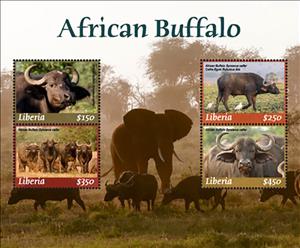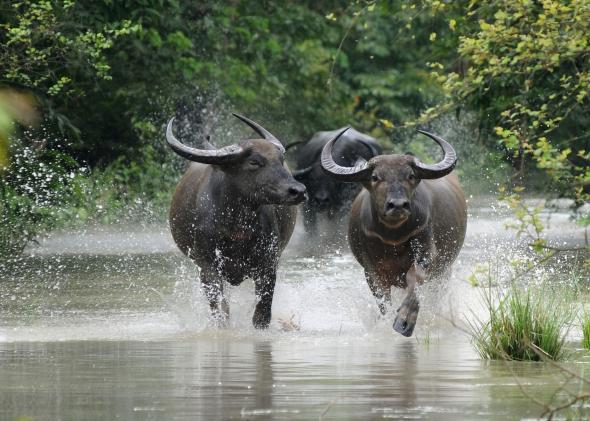Souvenir Sheet: African Buffalo (Liberia 2019)
African Buffalo (Liberia 2019)
19 April (Liberia ) within release African Buffalo (2019) goes into circulation Souvenir Sheet African Buffalo face value 1,200 Liberian dollar
| Souvenir Sheet African Buffalo in catalogues | |
|---|---|
| Colnect codes: | Col: LR 2019-06MS |
Souvenir Sheet is square format.
Also in the issue African Buffalo (2019):
- Stamp - African Buffalo face value 350;
- Stamp - African Buffalo face value 450;
- Souvenir Sheet - African Buffalo face value 800;
- Stamp - African Buffalo face value 150;
- Stamp - African Buffalo face value 800;
- Souvenir Sheet - African Buffalo face value 1,200;
- Stamp - African Buffalo face value 250;
Souvenir Sheet African Buffalo it reflects the thematic directions:
Animals are multicellular, eukaryotic organisms of the kingdom Animalia (also called Metazoa). All animals are motile, meaning they can move spontaneously and independently, at some point in their lives. Their body plan eventually becomes fixed as they develop, although some undergo a process of metamorphosis later on in their lives. All animals are heterotrophs: they must ingest other organisms or their products for sustenance.
Bubalina is a subtribe of wild cattle that includes the various species of true buffalo. Species include the African buffalo, the anoas, and the wild water buffalo (including the domesticated variant water buffalo). Buffaloes can be found naturally in sub-Saharan Africa, South Asia and Southeast Asia, and domestic and feral populations have been introduced to Europe, the Americas, and Australia.In addition to the living species, bubalinans have an extensive fossil record where remains have been found in much of Afro-Eurasia
Elephants are the largest living land animals. Three living species are currently recognised: the African bush elephant (Loxodonta africana), the African forest elephant (L. cyclotis), and the Asian elephant (Elephas maximus). They are the only surviving members of the family Elephantidae and the order Proboscidea; extinct relatives include mammoths and mastodons.
Mammals are any vertebrates within the class Mammalia (/məˈmeɪli.ə/ from Latin mamma "breast"), a clade of endothermic amniotes distinguished from reptiles (including birds) by the possession of a neocortex (a region of the brain), hair, three middle ear bones and mammary glands. All female mammals nurse their young with milk, secreted from the mammary glands. Mammals include the largest animals on the planet, the great whales. The basic body type is a terrestrial quadruped, but some mammals are adapted for life at sea, in the air, in trees, underground or on two legs. The largest group of mammals, the placentals, have a placenta, which enables the feeding of the fetus during gestation. Mammals range in size from the 30–40 mm (1.2–1.6 in) bumblebee bat to the 30-meter (98 ft) blue whale. With the exception of the five species of monotreme (egg-laying mammals), all modern mammals give birth to live young. Most mammals, including the six most species-rich orders, belong to the placental group. The largest orders are the rodents, bats and Soricomorpha (shrews and allies). The next three biggest orders, depending on the biological classification scheme used, are the Primates (apes and monkeys), the Cetartiodactyla (whales and even-toed ungulates), and the Carnivora (cats, dogs, seals, and allies).




